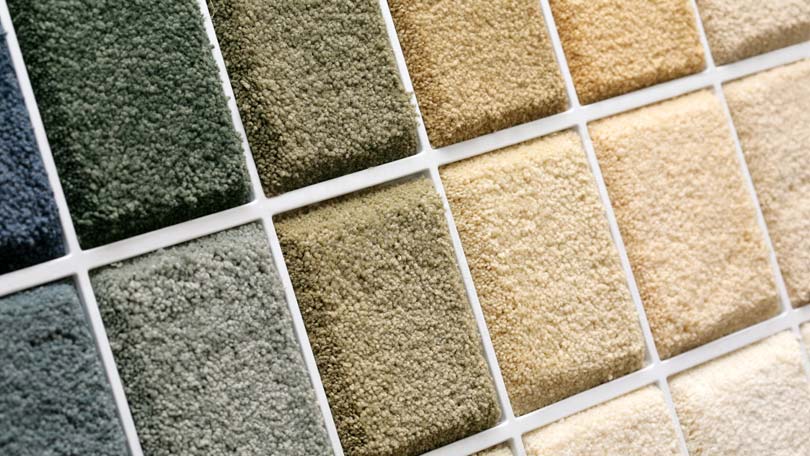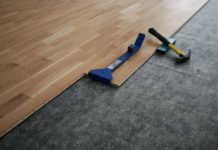
We spend a lot of time carefully shopping for the shoes we wear on our feet. But what about what we walk on with those shoes? If you’ve already ruled out wood flooring for your home, you’re probably wondering what your options are for a carpet. After all, how many different carpets can there be? And is it worth it to buy an expensive one?
Here’s a shopping guide to picking out the carpet that best suits your home and budget!
Have you ever wondered how a carpet is constructed? Essentially, a hand or power-operated machine is used to weave fabrics together that are then cut and attached to an underlay, which is then installed on a floor. The business of carpet construction began as long ago as the 900’s, in Spain! But traditionally, carpets were made to cover walls and tables, not floors. By the 1600’s, however, floor rugs – the predecessor of modern-day carpets – made their way to Europe.
Today, though, we think of rugs and carpets as very different animals. And indeed, they are. There are three basic types of carpets out there: woven, tufted, and needlefelt. Woven carpets can come in many colors and patterns and tend to have the biggest price tag attached to them. Tufted carpets are more efficiently produced, but commonly they are made with colorless yarn, which then has to be dyed the preferred color later. They are a lot more affordable than woven carpets. Tufted carpets are typically what regular consumers buy.
Needlefelt carpets are high-tech and enduring. Hotels and businesses often have needlefelt carpet installed; regular homeowners probably have little need for this extra sturdy carpet. There are many other details about carpet making that serve to create even more “divisions” of carpet types, but when you’re shopping for a carpet, these will be your three main choices. And for simplicity’s sake, it’s probably not best you get too lost in all the manufacturing jargon.
Carpets can be installed in many ways; usually its cushioned underlay is nailed to the floor. A carpet width of about 12 feet is average – but you can get “wall-to-wall” carpeting for a room or have it cut to fit only a certain part of it. It’s up to you.
So now that you understand the basics, let’s talk about how you should go about choosing a carpet for your home. First, you must take into consideration what style of carpet is best for the room. Do you want a pattern or a solid color? Do you plan on decorating the room later? You may want to choose a carpet color or pattern that will go with different kinds of furniture. Also ask yourself: “how durable does this carpet need to be?” If your carpeting a room that is not prone to wear and tear, you can save some money on the carpet you buy. Otherwise, you’ll want to invest a little money in a more durable carpet.
Once you’ve got a good vision for how you want your carpet to look, don’t get excited and buy it! First you have to measure the room. Unless you’re especially skilled with measuring tape and you understand carpet installation, it’s best to hire a professional to make the measurements for you. Then, you still don’t want to order the carpet right away. Instead, ask for a sample carpet piece and take it home with you, so you can see how it looks with the lighting. If you like it, then you can proceed to check-out.
In general, you want to make the most of your budget when shopping for a carpet. If you’re looking for a carpet that will last, you’ll have to buy a durable one and that probably won’t be the cheapest one on the market! That’s why it’s so vital that you buy the carpet from a reputable retailer and have it installed by skilled professionals. (This last part is something you must consider when you’re determining your budget as well.)
As far as carpets go, the more expensive ones really are the better ones. But don’t worry. When you’re buying a carpet, you’re making a lifetime investment and improving the value of your home. It’s worth every penny. Why buy a cheap carpet now only to have to pay for repairs and replacement later?
The three kinds of tufted carpets you’ll probably end up comparing are cut pile, loop pile, and cut and loop pile. Loop pile carpets are the most durable, but cut and loop pile hide dirt well. Where you will really see the difference in your carpet, however, is in what kind of fabric it is made out of. Polypropylene (or Olefin) is popular – and for good reason. It’s stain and water-resistant. Nylon and polyester, the latter being the cheapest, are also common choices and they work very well. Woven carpets are the most stylish, but the least stain resistant! Yet they are the most expensive, so watch out for this.
Now you have to choose a “face weight,” or the ounces of fiber per square yard. The weightier the carpet, the better. As well, the denser the fiber, the more comfortable the carpet will feel on your toes.
Look beneath the surface too! Ideally, you want a carpet that will be installed with brand-new underlay. Every carpet will have padding, and soft, thin padding is better than hard and thick.
Essentially, if you’re in the market for a carpet, you should spend as much as you can. As long as you choose a retailer that you trust and you understand all the vocabulary, you can effectively shop for a carpet that will last a long time.





